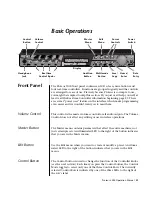
Composing with tELHARMONIC: DEGREE (Cont’d)
Here is what a partial sweep of Degree looks like with Interval set to Root Position and Tonic set to D. Note
that the resulting triads' sonorities always match their scale positions in the key of D Major/b minor:
When Interval is not set to Triad, Degree moves through the scale chromatically (12 possible values per
octave rather than the 7 Triads). For example here is part of a Degree sweep with Interval set to Fifth:
Using the D-GATE parameter it is possible to limit the amount of change in the DEGREE which will only
change when D-Gate is HIGH (keep in mind that D-GATE is normalled to +5V so that with nothing patched
to D-GATE, DEGREE will always be able to change). In this way the D-GATE allows the user to pick-off notes
and/ or chords from a continuous (or non-continuous) control voltage. It is a way of extracting melodies
and progressions from typically non-melodic sources such as LFOs, Envelopes, Expression Voltages or
Random Voltages. You could also use it to process Sequences where you do not want to utilize all notes in
the Sequence or to limit DEGREE changes to a tempo or clock within the system. By varying the Width of
the Gate signal patched to D-GATE to be narrow, you could grab single notes or chords from a control
voltage. By setting the width of the Gate signal patched to D-GATE to be wider, you could pick-off clusters
of notes or chords from a control source.
With each change in DEGREE a gate signal is generated and output at the GATE OUT. This gate is useful for
triggering events to coincide with a change in the Chord or Note generated by the tELHARMONIC, for
example an Envelope generator could be triggered to open a VCA or LPG each time the DEGREE is
changed.
INTERVAL :
This parameter controls the pitch spacing between the 3 Voices of the Harmonic and Phase Mod OUTs. The
Noise OUT is not controlled in any way by the INTERVAL parameter because the NOISE OUT is a single
voice.
The INTERVAL parameter starts with the TRIAD sonority at Full CCW. There are two Inversions of the TRIAD
as the INTERVAL parameter is increased. After the two Inversions, INTERVAL begins to continuously detune
and tune into Fifths followed by Unison and finally Octaves. There are many in-between tuning states
allowing for programming of complex, even dissonant, chords. The continuous nature of the detuning
and tuning makes INTERVAL modulate smoothly.
Here is what an F Major chord (as set by Degree and Tonic) looks like at all stages of the Interval parameter,
starting from full Counterclockwise:
Degree (Triads)
Degree (Fifths)
Interval
Содержание Soundhack tELHARMONIC
Страница 1: ...v 2 2...







































